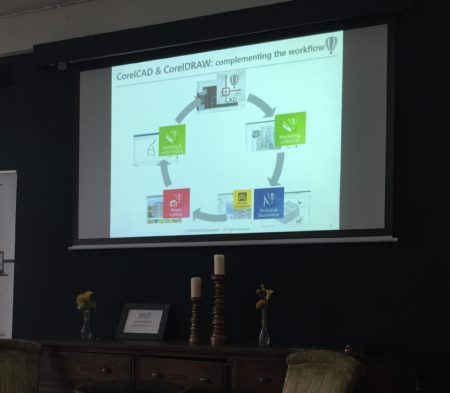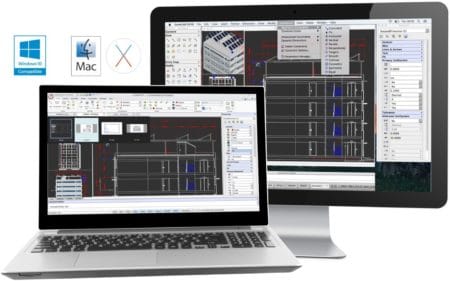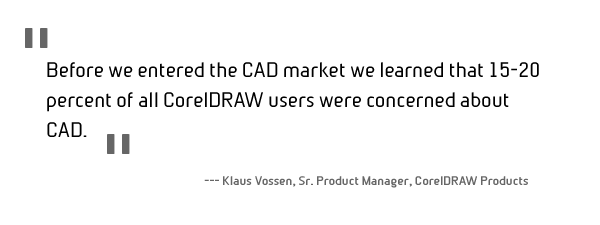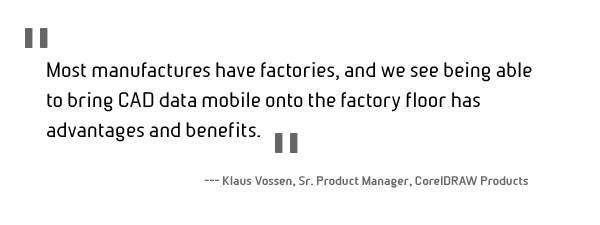In the 1990’s Corel Corporation was on a tear with its flagship product CorelDRAW®, a vector-based drawing application written originally for the Windows platform. It would later find its way on Unix and then Mac and OS X, but only briefly due to poor sales.
Chances are fairly good that many readers will recall Canada’s Corel Corporation for its late mid 90’s run-up against mighty Microsoft after the company acquired Novell’s WordPerfect software division, then locked into a contentiously strong battle with Microsoft’s Word.
While the latter half of the 1990’s saw Corel struggling in multiple new initiatives, including a failed attempt to become a primary Linux player, the core product that made Corel what it was, CorelDRAW, powered along.
Flash forward nearly two decades and Corel Corporation today consists of three mainstay brands, including CorelDRAW®, Painter®, and WordPerfect®. CorelCAD aims to have a strategic position under and related to the CorelDRAW brand.
CorelDRAW’s Market Power
The Canadian-based software corporation is a major enterprise software provider, but not because of its word processor—which is still thriving, particularly in the legal markets—but rather its technical drawing application CorelDRAW.
I had a chance to sit down with Klaus Vossen, senior product manager for CorelDRAW products in Berlin, while we both attended the Graebert Annual Meeting. He explained to me something that most people in the CAD world do not know. And that is that Corel has over 4 million active users on the “current version” alone and over 10 million CorelDRAW users in the world.
“Before we entered the CAD market we learned that 15-20 percent of all CorelDRAW users were concerned about CAD,” remarks Vossen, who went on to note the various geographies where CorelDRAW is particularly strong.
At 15 percent of 10 million overall CorelDRAW users, amounting to 1.5 million users, that is a very sizable market opportunity and one that Corel wasn’t going to pass up on. The company licensed Berlin-based Graebert’s ARES Commander CAD technology back in 2010 and entered the CAD market front on.
Manufacturers Eat Drawings for Breakfast
Corel’s enterprise customers consist of some of the largest industrial manufacturers in the world. The majority of the world’s leading automakers are Corel customers, who utilize its industry leading CoreDRAW Technical Suite as a complete technical communications solution for cross-media and publications.
“Auto manufactures not only work with CAD data but need to bring that CAD data into technical manuals for end-users and service-point technicians,” says Vossen.

01 – Corel Corporation’s CorelCAD serves a strategic place in its manufacture-oriented customers from SMB to enterprise global automakers who need to take CAD data into long-form technical manuals for operations and end-users. (image from Graebert Annual Meeting, Architosh. All rights reserved).
At the Annual Graebert Meeting in Berlin this past October, Vossen’s presentation showed a virtuous circle where Corel customers have solutions that enable them to capture, design, create and share—moving through a workflow that includes CAD in the middle at the design and creation stage.
At the end of that stage is CorelDRAW. That product is the bedrock of large departments in global enterprises that produce hundreds if not thousands of technical manuals filled with illustrations. While a product or part may begin its life in CATIA or Seimens’ NX pictures or views of it often end up in CorelDRAW.
Where CorelCAD is aiming is to be a key software piece in this circular workflow, enabling manufactures to work more easily with DWG based CAD data between CAD and CorelDRAW. To that end, CorelCAD can import and export to CorelDRAW and Corel Design directly.
A Complimenting Strategy
Manufacture-based enterprise customers aren’t the only segment of the market Corel CAD is aimed at.
Vossen said the AEC market is also a place for CorelCAD. The company has AEC customers who are using CorelCAD in both Canada, the United States and places like Germany, among others. “In Germany use is in more smaller AEC companies,” says Vossen.

02 – CorelCAD leverages Graebert’s ARES Commander code base and offers integrations with CorelDRAW and Corel Designer product lines for enhanced workflows for AEC and manufacturers.
Germany is a leading global manufacturer of products for buildings, such as windows and doors, roofing systems, equipment and appliances. All of these companies design and manufacturer. And all of these companies utilize CAD drawings. Over the past two and a half decades, a large number of these AEC companies have utilized AutoCAD and have vast amounts of DWG-based data. This too is a big market for Corel, where the company can go after both the technical illustration segment and the CAD segment of an AEC manufacturer, displacing or complimenting existing solutions.
Finally, a third major leg of the CorelCAD story is penetrating the market for design-side professionals in AEC, such as architects, engineers, and construction professionals. For those in this segment looking for AutoCAD alternatives at lower price points the Corel brand name may both resonate and provide comfort over rivals, including Graebert itself which is in the early stages of building its brand recognition in North America.
Brazil and the Mac
Speaking of geography, Vossen remarked that CorelCAD is very strong in Brazil, where CorelDRAW has a very large market base. From this market the company intends to build market share in other South American markets.
North America and Europe and strong manufacturing countries like Germany top the list for CorelCAD, but the company will face strong competition, including facing off against other DWG-native rivals like Bricscad. There were well over 2 billion DWG files in existence prior to the end of the last century, so the market for DWG CAD isn’t going away for quite some time, despite progress with BIM in AEC and PLM in MCAD.
Vossen said that when Corel decided to target the CAD market they had strong interest in offering multi-platform support, which is what they found in Graebert’s core technologies. “CorelCAD is also popular in education,” says Vossen, “where schools teach around the principles of CAD and not just around a specific application…in those schools CorelCAD is a very good choice.” Vossen said Corel has found in the educational market having support for the Mac has been an asset for getting into what he calls the “principled” CAD market.
The Future of CorelCAD
CorelCAD ships with one installer so the company keep track of activations. “20 percent of all activations are on the Mac platform,” notes Vossen. These Mac CorelCAD customers are in all segments, from big manufactures, AEC customers, and education. The one thing Vossen could add about its Mac customers is that as a group the Mac-based customers are more “vocal” about their needs.

03 – CorelCAD is fully compatible across Windows and Mac OS X platforms and the tablet versions are targeting Android first and iOS second. Image: Corel Corporation, all rights reserved.
Corel is looking at the tablet space in CAD now and will be releasing CorelCAD for Android tablets soon. This product matches in essence the ARES Touch product by Graebert, but will include Corel customizations. “Most manufactures have factories,” remarks Vossen, “and we see being able to bring CAD data mobile onto the factory floor has advantages and benefits.”
“Apple’s iPad tablets are key to Corel’s many enterprise customers,” says Vossen. In North America in particular the iPad has a dominant tablet market share. Corel is very interested in bringing their CAD solution to mobile tablets and are cooperating with Graebert in the tablet space. CorelCAD Mobile for Android is now ready and Apple’s iOS platform is next. Small businesses in Architecture and Engineering are a prime target and Vossen says they see an opportunity with CAD applications for Android devices.
Advertisement
Where CorelCAD will go over the next few years will be interesting to watch. Today’s CorelCAD product is based on ARES Commander by Graebert, a company that—as we have mentioned recently—has been accelerating innovation in the DWG CAD market. By licensing from a bold yet methodical OEM provider like Graebert, Corel today is better positioned with its CAD direction than in the mid-90’s when the company launched its first CorelCAD product based off of an entirely different code base.
Back when Corel was led by its bold but often criticized CEO founder, Michael Cowpland, the company reached the 1 million milestone with CorelDRAW in 1994. Two decades later that install base is 10 times larger in size. Unlike the first CorelCAD effort, today’s CorelCAD has a fate more closely aligned and better fitted for its purpose with supporting customers using CorelDRAW. It also includes some cutting edge code development from Berlin’s Graebert. As such, it is much more likely to see success in a very crowded and highly competitive CAD market.






Reader Comments
In Berlin – Klaus Vossen Explains Why @CorelCAD May Be Right for Your Company https://t.co/D5fnL66iwd by Anthony Frausto-Robledo #cad
In Berlin – Klaus Vossen Explains Why @CorelCAD May Be Right for Your Company https://t.co/D5fnL66iwd by Anthony Frausto-Robledo #cad
Comments are closed.